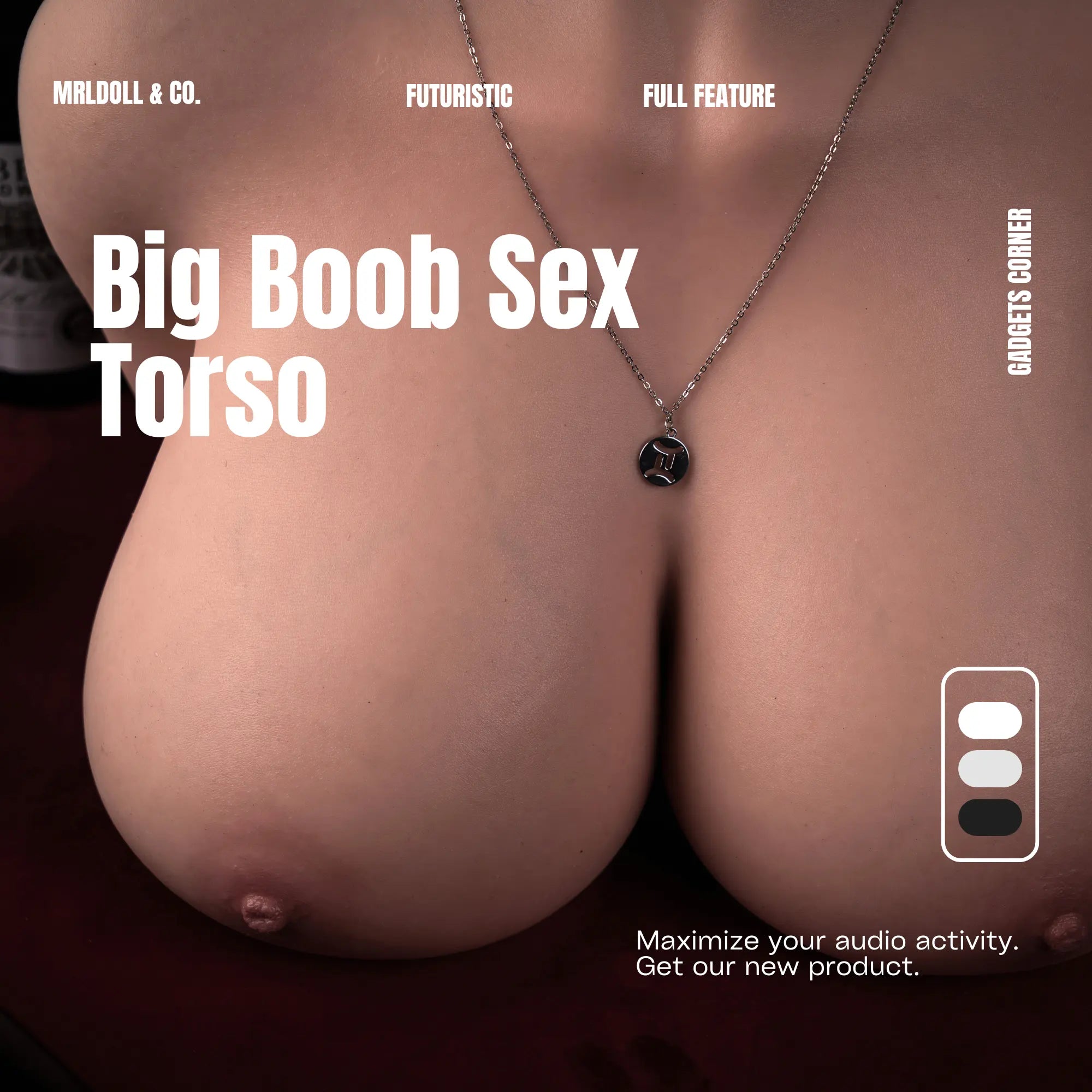Health and Truth: How Technology is Safeguarding Adult Consumers
Advancements in technology are revolutionizing the adult industry, prioritizing consumer safety through innovative materials like medical grade silicone, often referred to as Simulation Silicone. This material, celebrated for its lifelike texture and safety, is a cornerstone in products like sex dolls, torso dolls, and male sex toys. Beyond enhancing pleasure, technology ensures these products meet stringent health standards, reducing risks associated with intimate use. From non-porous materials to smart devices, the industry is evolving to protect users while delivering satisfying experiences. This article explores how Simulation Silicone and other innovations safeguard adult consumers, offering practical insights into material safety, regulatory frameworks, and proper maintenance practices. Whether you're curious about male sex toys or seeking a reliable torso Doll, understanding these advancements empowers informed choices.
The Critical Role of Safe Materials in Adult Products
The materials used in adult products directly impact user health, making safety a top priority. Porous materials like jelly rubber or polyvinyl chloride (PVC) can harbor bacteria and mold, increasing infection risks. Studies have shown that PVC often contains phthalates, chemicals linked to hormonal disruptions and reproductive issues. A 2023 study highlighted how phthalates in sex toys could leach into the body, potentially causing long-term health concerns (ScienceDirect: Health Risks of Sex Toys). In contrast, medical grade silicone—a non-porous, hypoallergenic material—offers a safer alternative. Known as Simulation Silicone in high-end sex dolls and male sex toys, it resists bacterial growth and is easy to clean. This silicone’s flexibility and realistic feel make it ideal for torso dolls, ensuring both safety and satisfaction. By choosing products made with Simulation Silicone, consumers minimize health risks while enjoying durable, high-quality designs. Understanding material differences empowers users to prioritize health without compromising experience.
Decoding Silicone in Adult Toys
Silicone is a buzzword in the adult industry, but not all silicones are created equal. Medical grade silicone, used in premium sex dolls and male sex toys, meets strict FDA standards for biocompatibility, ensuring it’s safe for prolonged skin contact. Unlike cheaper blends like TPE (thermoplastic elastomer), which may be porous and less durable, 100% platinum-cured silicone—often branded as Simulation Silicone—is non-toxic and resistant to degradation. This makes it a top choice for torso dolls, where lifelike texture is paramount. According to a 2024 guide, platinum-cured silicone avoids harmful additives, reducing allergic reactions (Holistic Wisdom: Silicone Safety). However, some manufacturers mislabel TPE as silicone, confusing consumers. Learning to identify true Simulation Silicone through product certifications or reputable brands ensures safety. This knowledge is vital for anyone investing in male sex toys or sex dolls, as it guarantees a product that’s both enjoyable and health-conscious.
How to Spot Authentic Silicone Toys
Identifying genuine medical grade silicone is crucial to avoid health risks. Start with a touch test: true Simulation Silicone feels firm yet flexible, never sticky or oily, unlike TPE blends. Smell is another clue—authentic silicone lacks a chemical odor, while fakes may emit a plastic-like scent. Check labels for phrases like “100% platinum-cured silicone” or “medical grade silicone”; vague terms like “silicone blend” are red flags. Reputable brands often provide material certifications, so contacting manufacturers for verification is wise. A 2024 consumer guide recommends buying from trusted retailers to avoid counterfeits (Wired: Choosing Safe Sex Toys). For sex dolls or male sex toys, these steps ensure you’re getting a safe, durable product. Avoid flame tests, as they’re unreliable and risky. Prioritizing verified Simulation Silicone protects your health and enhances your experience.
Technological Advances in Material Safety
Technology has transformed adult product safety, particularly through innovations in medical grade silicone. Platinum-cured silicone, used in Simulation Silicone for sex dolls and torso dolls, minimizes chemical leaching compared to older peroxide-cured methods. This advancement reduces toxicity risks, making products safer for intimate use. Research from 2023 confirms that platinum-cured silicone outperforms other materials in biocompatibility tests (ScienceDirect: Material Safety). Beyond materials, smart technologies like teledildonics—seen in app-controlled male sex toys—enhance user control while maintaining safety through seamless, non-porous designs. These devices often use Simulation Silicone for its durability and realistic feel. Manufacturers also employ precision molding to eliminate crevices where bacteria could grow, ensuring torso dolls and other products are hygienic. These technological strides reflect a commitment to consumer health, blending innovation with practicality.
Medical Grade Silicone: The Gold Standard
Medical grade silicone sets the benchmark for adult product safety. Its non-porous nature prevents bacterial growth, and its ability to withstand high-temperature sterilization (like boiling) ensures thorough cleaning. Used in Simulation Silicone for sex dolls, it’s hypoallergenic, reducing irritation risks for sensitive skin. A 2024 analysis praised its longevity, noting that medical grade silicone resists wear even with frequent use (Greenopedia: Safe Sex Toys). This durability makes it cost-effective for male sex toys and torso dolls. Unlike glass or metal, silicone offers a softer, skin-like texture, balancing safety with comfort. When shopping, look for explicit “medical grade” labeling to ensure compliance with health standards. This material’s reliability makes it a cornerstone of modern adult products, safeguarding users while delivering premium experiences.
Alternative Safe Materials: Glass and Metal
While Simulation Silicone dominates, borosilicate glass and stainless steel are also safe options. Glass is non-porous, shatter-resistant, and compatible with all lubricants, making it versatile for male sex toys. Its ability to retain heat or cold adds sensory variety. Stainless steel, equally non-porous, is durable and easy to sterilize, ideal for torso dolls with metal components. A 2024 safety guide notes that both materials resist bacterial buildup, offering long-term hygiene (Wired: Choosing Safe Sex Toys). Unlike porous plastics, they don’t degrade or harbor odors. However, their firmness may not suit everyone, unlike the pliable medical grade silicone. Exploring these alternatives allows consumers to diversify their collection while maintaining safety, ensuring every sex doll or toy meets health-conscious standards.
Regulatory Landscape and Consumer Protection

The adult industry lacks universal regulations, but strides are being made to protect consumers. In the U.S., the Consumer Product Safety Commission (CPSC) doesn’t specifically oversee sex toys, leaving gaps in oversight. However, the 2021 ISO 3533 standard provides global guidelines for material safety, electrical components, and labeling in sex toys. This standard helps manufacturers ensure products like sex dolls and male sex toys meet basic safety criteria (ComplianceGate: Sex Toy Regulations). Consumers must scrutinize labels for medical grade silicone certifications and avoid vague claims. Reputable brands align with ISO 3533, using Simulation Silicone to guarantee safety. By understanding these frameworks, users can choose torso dolls or other products with confidence, knowing they’re backed by emerging industry standards that prioritize health.
The Impact of Standards and Certifications
Standards like ISO 3533 play a pivotal role in enhancing product safety. They mandate non-toxic materials, clear labeling, and safe mechanical designs, reducing risks in sex dolls and male sex toys. A 2024 report noted that ISO-compliant products showed lower chemical leaching rates, protecting users from harmful exposure (ComplianceGate: Sex Toy Regulations). Certifications from labs like ISO 17025 further validate material quality, ensuring Simulation Silicone meets health standards. For consumers, these benchmarks simplify choosing safe torso dolls or male sex toys. However, adoption remains voluntary, so verifying certifications is key. Understanding these standards empowers users to demand transparency from manufacturers, fostering a safer market for medical grade silicone products.
What to Look for on Product Labels
Deciphering labels is essential for safe purchases. Seek terms like “100% platinum-cured silicone” or “medical grade silicone” to confirm quality. Avoid products labeled “silicone blend” or “body-safe” without specifics, as these may include porous materials. Reliable manufacturers provide contact details for inquiries, a sign of transparency. For sex dolls or torso dolls, check for ISO 3533 compliance or FDA-grade certifications. A 2024 consumer guide advises emailing brands to verify Simulation Silicone authenticity. Clear labeling ensures you’re investing in safe male sex toys, protecting your health and enhancing trust in your purchase.
Health Risks of Using Substandard Adult Toys

Substandard adult toys pose significant health risks, particularly those made with porous or toxic materials. PVC and jelly rubber can trap bacteria, leading to infections like bacterial vaginosis or yeast infections. These materials often contain phthalates, which studies link to endocrine disruption and fertility issues. A 2023 study found that PVC toys release microplastics, potentially causing inflammation when absorbed (Springer: Microplastics in Sex Toys). Such risks underscore the importance of choosing medical grade silicone, like Simulation Silicone, for sex dolls and male sex toys. Poor-quality torso dolls may also degrade, releasing harmful chemicals during use. By opting for non-porous materials, consumers avoid these dangers, ensuring their intimate experiences remain safe and enjoyable. Awareness of these risks drives demand for safer, technology-driven products.
Chemical Leaching and Microplastic Concerns
Chemical leaching is a major concern with low-quality adult toys. Phthalates in PVC can seep into the body, disrupting hormones and potentially causing reproductive harm. Microplastics, tiny particles released from degrading toys, pose additional risks. A 2024 study confirmed that microplastics from sex toys could trigger oxidative stress, leading to inflammation in sensitive tissues (Springer: Microplastics in Sex Toys). These issues are absent in medical grade silicone, making Simulation Silicone a safer choice for torso dolls and male sex toys. Non-porous sex dolls resist degradation, ensuring no harmful substances are released. Consumers must prioritize certified materials to avoid these hidden dangers, safeguarding their health while enjoying their products.
Research on Sex Toy Safety
Scientific studies highlight the safety gap between materials. A 2023 analysis compared PVC and silicone toys, finding that medical grade silicone exhibited minimal toxicity, while PVC released high phthalate levels (ScienceDirect: Health Risks of Sex Toys). Platinum-cured Simulation Silicone, used in sex dolls, showed superior stability, reducing health risks. These findings emphasize the need for informed material choices in male sex toys and torso dolls. Ongoing research advocates for stricter regulations to eliminate harmful materials, reinforcing the value of medical grade silicone as a consumer-safe standard.
Best Practices for Maintaining Adult Toys

Proper maintenance extends the life of adult toys and ensures hygiene. Regular cleaning prevents bacterial buildup, especially for sex dolls and male sex toys made with Simulation Silicone. Use warm water and fragrance-free antibacterial soap, avoiding silicone-based soaps that can degrade medical grade silicone. For thorough disinfection, boil non-electronic torso dolls (check manufacturer guidelines first). Dry toys completely before storing in a breathable bag to prevent mold. A 2024 cleaning guide stresses avoiding dimethicone-containing products, which can damage silicone surfaces (Wirecutter: Cleaning Sex Toys). Store sex dolls away from sunlight to preserve material integrity. These practices ensure your male sex toys remain safe and functional, enhancing both health and enjoyment.
Cleaning Silicone-Based Toys
Cleaning medical grade silicone toys is straightforward but requires care. Rinse with warm water and apply a mild, unscented antibacterial soap, scrubbing gently to remove residues. For Simulation Silicone in sex dolls, avoid abrasive sponges that could scratch surfaces. Non-electronic torso dolls can be boiled for 5-10 minutes for sterilization, but confirm heat tolerance with the manufacturer. Dry thoroughly with a lint-free cloth to prevent moisture buildup. A 2024 hygiene guide warns against dishwashers, as detergents can degrade male sex toys (Wirecutter: Cleaning Sex Toys). Regular cleaning maintains the safety and longevity of medical grade silicone, ensuring your sex doll remains a hygienic companion.
Common Maintenance Mistakes to Avoid
Avoid these pitfalls to keep your toys safe:
Using silicone lubricants: They can break down Simulation Silicone, causing stickiness. Stick to water-based options.
Improper storage: Storing sex dolls in humid or sunny areas promotes mold or degradation. Use a cool, dry place.
Sharing without cleaning: Always clean male sex toys before sharing, and use condoms to prevent infections.
Harsh cleaners: Bleach or alcohol can damage medical grade silicone. Opt for mild soap.
A 2024 guide highlights these errors as common causes of toy damage (Greenopedia: Safe Sex Toys). Proper care ensures your torso dolls tays safe and enjoyable.
FAQ
1.How Does Silicone Compare to Other Materials?
Medical grade silicone, like Simulation Silicone, is non-porous, hypoallergenic, and easy to clean, unlike PVC, which may contain phthalates and harbor bacteria. Glass and metal are also safe but less flexible. For sex dolls and male sex toys, silicone offers a skin-like feel, making it ideal for realistic torso dolls. Always choose certified medical grade silicone for safety.
2.How Can I Tell If My Toy Is Real Silicone?
Check for “100% platinum-cured silicone” or “medical grade silicone” on the label. True Simulation Silicone feels firm, not sticky, and has no chemical smell. Buy from reputable brands and verify certifications. For sex dolls or male sex toys, contact manufacturers if labels are unclear to ensure safety.
3.Are There Regulations for Sex Toys in the U.S.?
The U.S. lacks specific sex toy regulations under the CPSC, but ISO 3533 (2021) offers global safety guidelines for materials and design. Look for medical grade silicone certifications in sex dolls and torso dolls. Consumers should research brands to ensure compliance with safety standards (ComplianceGate: Sex Toy Regulations).
4.Can I Sterilize Silicone Toys?
Yes, medical grade silicone toys, like those with Simulation Silicone, can often be boiled for 5-10 minutes to sterilize, ideal for male sex toys. Check for electronic components first, as they require gentler cleaning. Always follow manufacturer instructions to avoid damage (Wirecutter: Cleaning Sex Toys).
5.What Are the Risks of Low-Quality Toys?
Low-quality toys, often made with PVC, can cause infections due to bacterial buildup and release phthalates or microplastics, risking hormonal issues or inflammation. Choosing Simulation Silicone for sex dolls or torso dolls eliminates these dangers, ensuring safer intimate experiences (Springer: Microplastics in Sex Toys).










